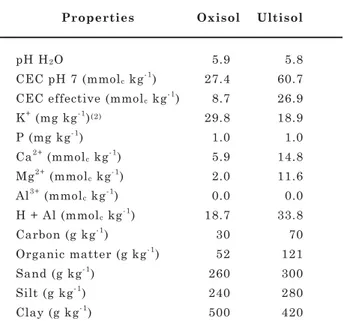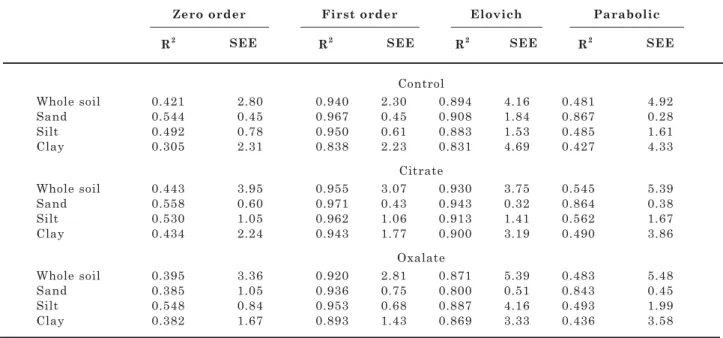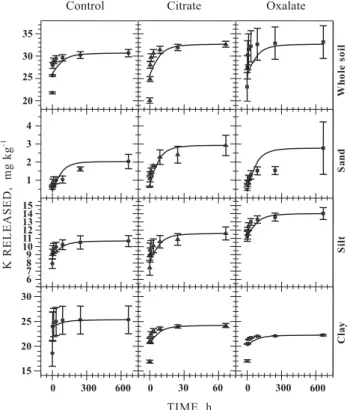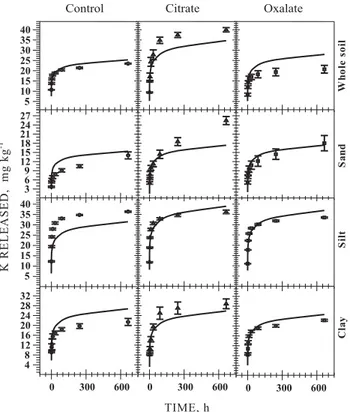KINETICS OF K RELEASE FROM SOILS OF BRAZILIAN
COFFEE REGIONS: EFFECT OF ORGANIC ACIDS
(1)Vladimir Antônio Silva(2), Giuliano Marchi(3), Luiz Roberto Guimarães Guilherme(4), José Maria de Lima(4), Francisco Dias
Nogueira(5) & Paulo Tácito Gontijo Guimarães(5)
SUMMARY
Kinetic studies on soil potassium release can contribute to a better understanding of K availability to plants. This study was conducted to evaluate K release rates from the whole soil, clay, silt, and sand fractions of B-horizon samples of a basalt-derived Oxisol and a sienite-derived Ultisol, both representative soils from coffee regions of Minas Gerais State, Brazil. Potassium was extracted from each fraction after eight different shaking time periods (0–665 h) with either
0.001 mol L-1 citrate or oxalate at a 1:10 solid:solution ratio. First-order, Elovich,
zero-order, and parabolic diffusion equations were used to parameterize the time dependence of K release. For the Oxisol, the first-order equation fitted best to the experimental data of K release, with similar rates for all fractions and independent of the presence of citrate or oxalate in the extractant solution. For all studied Ultisol fractions, in which K release rates increased when extractions were performed with citrate solution, the Elovich model described K release kinetics most adequately. The highest potassium release rate of the Ultisol silt fraction was probably due to the transference of “non-exchangeable” K to the extractant solution, whereas in the Oxisol exchangeable potassium represented the main K source in all studied fractions.
Index terms: successive extractions, first order, zero order, parabolic diffusion, Elovich.
(1) Part of the Thesis submitted by the first author for the degree of Master of Soil Science and Plant Nutrition at Universidade
Federal de Lavras – UFLA. Received for publication in november of 2006 and approved in october of 2007.
(2) Instituto Nacional de Colonização e Reforma Agrária – INCRA. Rua Olhos D’água 829, Bairro Candolas, CEP 38900-000
Bambuí (MG). E-mail: vladimirsilva@bhe.incra.gov.br
(3) Embrapa Cerrados. Rod. BR 020, km 18, Caixa Postal 08223, CEP 73310-970 Planaltina (DF). E-mail:
giuliano.marchi@cpac.embrapa.br
(4) Associate Professor, Departamento de Ciência do Solo, Universidade Federal de Lavras – DCS/UFLA. Caixa Postal 3037,
CEP 37200-000 Lavras (MG), E-mail: guilherm@ufla.br; jmlima@ufla.br
(5) Empresa de Pesquisa Agropecuária de Minas Gerais – EPAMIG. CEP 37200-000 Lavras (MG). E-mail: paulotgg@ufla.br;
nogueirabiotech@navinet.com.br
RESUMO: CINÉTICA DE LIBERAÇÃO DO POTÁSSIO EM SOLOS DE REGIÕES CAFEEIRAS: EFEITO DE ÁCIDOS ORGÂNICOS
Estudos de cinética de liberação de K podem contribuir para avaliação da disponibilidade deste nutriente no solo para as plantas. Este trabalho teve como objetivos investigar a cinética de liberação do potássio nas frações terra fina, areia, silte e argila de dois solos do Estado de Minas Gerais, Brasil, originalmente cultivados com cafeeiro e comparar quatro equações para descrevê-la. As frações foram submetidas a oito extrações sucessivas (0 a 665 h) com citrato e oxalato 1 mmol L-1, sendo os resultados de K liberado somados e plotados em função do tempo. Foram comparadas as equações de ordem zero, primeira ordem, Elovich e parabólica de difusão, a fim de verificar qual delas melhor descreve a cinética. Na condução do experimento utilizaram-se amostras do horizonte B de um Latossolo Vermelho distroférrico originado de basalto e de um Nitossolo originado de sienito nefelínico. Para cada equação foram calculados o coeficiente de correlação (r) e o erro-padrão da estimativa (EP). A equação de primeira ordem descreveu melhor os resultados do Latossolo e a equação de Elovich se ajustou melhor aos resultados do Nitossolo. As velocidades de liberação do K para o Latossolo foram semelhantes em todas as frações estudadas, não sendo observado efeito dos ácidos orgânicos na velocidade de liberação do K, porque a maior parte do K liberado foi proveniente da forma trocável. No Nitossolo, o citrato acelerou a liberação do K em todas as frações estudadas, e a fração silte foi a que apresentou maior velocidade, pois possivelmente a maior parte do K proveniente desta fração estava na forma não-trocável.
Termos de indexação: extrações sucessivas, primeira ordem, ordem zero, Elovich, parabólica de difusão.
INTRODUCTION
The low natural K reserves in most tropical soils (Melo et al., 2000; Wood et al., 2000) and the dependence of Brazilian agriculture on imported K justify research efforts on the rational use of K fertilization in Brazil. The prediction of yield response to K fertilizer applications based on soil tests for exchangeable K is sometimes of limited accuracy (Pal et al., 2001), particularly for perennial crops such as coffee. The K uptake from nonexchangeable forms by plants has been described (Fitzpatrick & Guillard, 2004) and several mineralogical studies confirmed great differences among soils concerning the K-supply potential.
Studies on the mineralogy and distribution of K among different soil compartments can contribute to a better understanding of K dynamics. However, these studies provide little information on soil K behavior when the exchangeable pool is depleted. K release and its availability can be estimated in successively cultivated soils, requiring long-term experiments (Benipal & Pasricha, 2002).
Successive extractions of K from soils by chemical extractants can simulate the absorption of available K by plants, providing short-term results, which allow the evaluation of K release from soil compartments, e.g., from different granulometric fractions, and complement studies on K mineralogy or even on successive crop cultivation. Nevertheless, mineral weathering rates in the rhizosphere may be higher
than in the bulk soil (Ochs et al., 1993). In this context, the use of low molecular weight organic acids as extractants is recommended to mimic the plant environment.
Organic ligands such as citrate and oxalate are involved in K release reactions in the soil and have been used as extractants in successive extraction experiments in Brazil (Meurer & Castilhos, 2001) and elsewhere (Srinivasarao et al., 2006). The great affinity of Brazilian Oxisols for citrate and oxalate (Marchi et al., 2006b) and the influence of these organic acids on exchangeable Al (Li et al., 2005) as well as on the surface charge (Marchi et al., 2006a) of variable-charge soils also calls for a better understanding of their effect on other soil properties, e.g., on plant nutrient availability.
The most commonly used mathematical equations to investigate the kinetics of soil K release are zero order, first order, Elovich, and parabolic diffusion (Martin & Sparks, 1983; Lopez-Pineiro & Navarro, 1997; Mengel et al., 1998; Singh et al., 2002, Srinivasarao et al., 2006). Once the best fitting model is found, K release rates for each soil material can be compared.
and an Ultisol in Minas Gerais State under coffee; and (b) to find the best fitting mathematical model to describe K release kinetics in each studied soil fraction.
MATERIAL AND METHODS
Samples were collected from the B horizon of a basalt-derived Oxisol from São Sebastião do Paraíso (80–120 cm depth), and of a sienite-derived Ultisol from Poços de Caldas (65–85 cm depth), both representative soils of coffee regions in Minas Gerais State, Brazil (Table 1).
The samples were air-dried, sieved (2 mm mesh) and dispersed with 0.1 mol L-1 NaOH. The suspension
was submitted to ultrasonic dispersion for 10 min (Misonix, XL2020; 20 kHz) and then fractionated into sand (> 50 μm) - by sieving - silt (2–50 μm), and clay (< 2 μm) - by centrifugation (Jackson, 1975).
For K extractions by citrate and oxalate solutions (concentration = 0.001 mol L-1 in 0.03 mol L-1 NaCl;
pH = 5.5; Table 2), 4 g of each fraction and 40 mL of the extractant solution were filled into 100 mL centrifuge tubes. These tubes were shaken constantly for 1.0, 2.72, 4.48, 12.18, 33.11, 90.02, 244.69, and 665.14 h using an end-over shaker, and after each extraction period, the tubes were centrifuged at 2.800 g for 15 min. Three replications were performed. After every extraction, the supernatant was discarded and a new extractant solution added. K in the supernatant was analyzed by flame photometry.
Zero-order, first-order, Elovich, and parabolic diffusion models were tested statistically to determine which one fitted best to the data on K kinetics release for each soil and soil fraction.
The zero-order equation was calculated as:
K∞ – Kt = – kt (1)
where K∞ denotes the accumulated amount of K released over all extractions (mg kg-1); K
t denotes the
accumulated amount of K released in the time period t (mg kg-1); k denotes the zero-order rate constant
(mg kg-1 h-1), and t denotes the time (h).
The first-order equation was calculated as (Martin & Sparks, 1983):
ln (K∞ – Kt) = – k’t (2)
where k’ denotes the release rate constant for the first order reaction (h-1), and the elements of the equation
are as described for equation 1.
The simplified parabolic diffusion equation was as follows (Melo et al., 2005; Galadima & Silvertooth, 1998):
Kt K∞-1 = a + k” (t1/2) (3)
where a denotes the initial rate constant and refers to the Kt intercept of the straight line plot of lnKt vs. lnt; k” denotes the slope of the fitted line for the K diffusion rate, and the other elements of the equation are as described for equation 1.
Table 2. Dissociation constants (pK and pK’ for background solution = 0.03 mol L-1 as NaCl) of the organic
acids and stability constants (logKs) of K–organic anion complexes
(1) Z: charge at pH 5,5 (Skoog et al., 1997). (2) log K
s for K-oxalate-1 and K-citrate-2 (Martell & Smith, 2003). MW: molecular weight;
pK’ = pK (0.5 ((z2
HB–z2B)I1/2)/1 + I1/2); I (ionic strength) = 0.03 mol L-1.
Table 1. Chemical properties and particle size
distribution(1) of B-horizon samples from a
basalt-derived Oxisol and a sienite-derived Ultisol of coffee regions in Minas Gerais State, Brazil
(1) Embrapa (1979). (2) Mehlich-1 extracted (0.05 mol L-1 HCl +
The Elovich equation was as follows (Galadima & Silvertooth, 1998; Bedrossian & Singh, 2004):
Kt = a + k” lnt (4)
all terms as previously described.
The best-fitting equation was identified based on the coefficient of determination of the linearized equations (R2) and the standard error of estimate
(SEE) defined by: SEE = [Σ (Kt–Kt*)2 / (n–2)]½, where
Kt and Kt* are the respective experimental and model-estimated K released amounts and n is the number of observations (Jardine & Sparks, 1984).
RESULTS AND DISCUSSION
The first order and the Elovich models were the equations that best fitted the experimental data, in agreement with results reported elsewhere (Lopez-Pineiro & Navarro, 1997; Mengel et al., 1998; Srinivasarao et al., 2006). For the Oxisol, the first-order equation best described K release to the extractant solution, whereas the zero order and parabolic diffusion equations did not fit the experimental data (Table 3). The results for K extraction by citrate and oxalate were similar to those found by Zhu & Luo (1993) for 12 soils from China and by Song & Huang (1988), which used the same extractants for K extraction from biotite, muscovite, microcline, and orthoclase.
The K release rates (k’)1 estimated by the
first-order equation for all fractions of the studied Oxisol
were similar for the citrate and oxalate extractant solutions (Table 4).
The greatest differences in K-release rates (first-order constants, k’) were verified for the clay fraction, where the K extraction rate by citrate solution (0.01139 h-1) was by 7.4 and 5.5 % higher than for
control and oxalate, respectively.
Great part of the extracted K from the Oxisol came from the exchangeable form (Mehlich-1, Table 1). The use of organic acids increased the K release from silt and sand fractions, which shows that these two fractions represent the main K reserve of this soil (Figure 1).
For the Ultisol, the Elovich equation fitted the experimental results best (Table 5), indicating that K release from this soil is a diffusion-controlled process (Cox & Joern, 1997).
Table 3. Coefficient of determination (R2) and standard error of estimate (SEE; mg kg-1) values for the
equations used to describe the K release (zero order, first order, Elovich, and parabolic) from the whole soil, sand, silt, and clay fractions of the studied Oxisol
Table 4. First-order rate coefficients (k’; h-1) for the
K release from the whole soil, sand, silt, and clay fractions of the studied Oxisol for the different extractants
The k” from the Elovich equation can be used to compare different materials in relation to the K release rates (Martin & Sparks, 1983; Cox & Joern, 1997). Citrate extractant caused higher k” values than oxalate, except for the silt fraction (Table 6). The oxalate extractant was very similar to the control.
The k” values extracted by citrate from the Ultisol whole soil fraction were 89 and 108 % higher than for the control and oxalate, respectively. This difference is due to the K released from the nonexchangeable pool, as the cumulative values for K extraction kinetics were almost twice as high as those of exchangeable K (Mehlich-1, Table 1).
The citrate extraction also increased the amount of K extracted from the sand fraction, where the amount of released K was greater by 81 and 37 % when extracted with citrate than with control and oxalate, respectively. The k” value was smaller in the sand, indicating that nonexchangeable-K release is a slow process in this fraction.
For the Ultisol silt fraction, the k” coefficients were similar, probably because almost all K was released from exchangeable K. The k” coefficient for the clay fraction was 46 and 39 % greater in citrate extracts than in control and oxalate, respectively.
Most K from the Ultisol silt fraction was more rapidly released than from the clay and sand fractions of this soil (Figure 2). For all granulometric fractions of this soil, extractions by citrate were faster than by the control and oxalate extractant. The higher K extraction capacity of citrate compared with oxalate
Figure 1. Experimental and first-order equation-fitted data for the kinetics of K release from the whole soil, sand, silt, and clay factions of the
studied Oxisol to the control (0.03 mol L-1 NaCl),
citrate (0.001 mol L-1 in 0.03 mol L-1 NaCl), and
oxalate (0.001 mol L-1 in 0.03 mol L-1 NaCl)
extractant solutions.
Table 5. Coefficient of determination (R2) and standard error of estimate (SEE; mgkg-1) values for the
Table 6. Slope coefficients (k”; mg kg-1 [Ln(h)]-1) of the Elovich equation used to describe the K release from the whole soil, sand, silt, and clay fractions of the studied Ultisol with different extractants
(1) 0.03 mol L-1 NaCl. (2) 0.001 mol L-1 in 0.03 mol L-1 NaCl.
Figure 2. Experimental and Elovich equation-fitted data for the kinetics of K release from the whole soil, sand, silt, and clay factions of the studied
Ultisol by the control (0.03 mol L-1 NaCl), citrate
(0.001 mol L-1 in 0.03 mol L-1 NaCl), and oxalate
(0.001 mol L-1 in 0.03 mol L-1 NaCl) extractant
solutions.
might be related to the higher value of the stability constant (Ks) for the formation of K-citrate when compared with K-oxalate complexes (Martell & Smith, 2003; Table 2).
The most important fraction in terms of K release from the Ultisol was silt, in which the k” value was highest in all treatments. In this case, the higher k”
values were due to greater amounts of K released from the nonexchangeable pool. Similar results were reported by Mengel et al. (1998) in loess-derived soils and by Castilhos et al. (2002) and Villa et al. (2004) in lowland soils.
The smaller difference in terms of extraction capability between citrate and oxalate in the Oxisol compared with the Ultisol might be related to the surface charge of each soil. Since the cation exchange capacity of the Oxisol is about 4 times lower than of the Ultisol (Table 1), a greater anion adsorption is expected in the first (an oxidic soil) than in the second (Marchi et al., 2006b). Citrate is therefore less adsorbed in the Ultisol and since it has a higher charge and higher Ks (Martell & Smith, 2003) then oxalate
(Table 2), it would be able to extract more K via formation of a K-organic acid complex.
Despite the higher exchangeable K in the Oxisol than in the Ultisol, the long-term K release was greater in the Ultisol, as the total cumulative K release at the end of kinetics shows (Figures 1 and 2). This shows that much of the K from the Ultisol can come from the non exchangeable fraction and that organic acids play an important role in this process, since the cumulative K release was higher for organic acids compared with the control. Also, the importance of the soil surface charge must be taken into account when evaluating the effect of organic acids on K extraction, e.g., a more weathered soil, such as an Oxisol will adsorb more organic anions than an Ultisol (Marchi et al., 2006b), thus reducing the capability of the organic acids to work as effective soil potassium extractants.
Studies on K uptake by plants in these soils are necessary to validate the K-release kinetics and to define the best mathematical modeling and the coefficients to be used as ancillary indexes to evaluate K availability to plants most adequately. This should be evaluated in future research.
CONCLUSIONS
1. The kinetics of K release differed between soils and among their granulometric fractions.
2. The K release was fast during the initial extractions, followed by a slow release after 300 hours. 3. The first-order equation fitted to the K release in the Oxisol was most adequate, whereas in the Ultisol the process was better described by the Elovich model.
4. The organic acid effects on the slope of K release were greater for the Ultisol than for the Oxisol.
LITERATURE CITED
BEDROSSIAN, S. & SINGH, B. Kinetics of potassium release from Vertisols from northern NSW. In: SUPERSOIL 2004: A U S T R A L I A N N E W Z E A L A N D S O I L S CONFERENCE, December 2004. Sydney, University of Sydney, Australia. Available at: <http:// w w w . r e g i o n a l . o r g . a u / a u / a s s s i / s u p e r s o i l 2 0 0 4 / p d f / 1675_bedrossians.pdf>.
BENIPAL, D.S. & PASRICHA, N.S. Nonexchangeable K release and supplying power of Indo-Gangetic alluvial soils. Geoderma, 108:197-206, 2002.
CASTILHOS, R.M.; MEURER, E.J.; KÄMPF, N. & PINTO, L.F.S. Mineralogia e fontes de potássio em solos no Rio Grande do Sul cultivados com arroz irrigado. R. Bras. Ci. Solo, 26:579-587, 2002.
COX, A.E. & JOERN, B.C. Release kinetics of nonexchangeable potassium in soils using sodium tetraphenylboron. Soil Sci., 162:588-598, 1997.
EMPRESA BRASILEIRA DE PESQUISA AGROPECUÁRIA -EMBRAPA. Serviço Nacional de Levantamento e Conservação de Solos. Manual de métodos de análise de solo. Rio de Janeiro, 1979. 412p.
FITZPATRICK, R.J.M. & GUILLARD, K. Kentucky bluegrass response to potassium and nitrogen fertilization. Crop Sci., 44:1721-1728, 2004.
GALADIMA, A. & SILVERTOOTH, J.C. Mathematical models of potassium release kinetics for sonoran desert soils of Arizona In: SILVERTOOTH, J.C. Cotton. A College of Agriculture Report, 1998. Tucson, College of Agriculture, The University of Arizona, Tucson, Arizona, 85721. Available at: <http://ag.arizona.edu/pubs/crops/az1006/ az10068f.html>.
JACKSON, M.L. Soil Chemical analysis: Advanced course. Madison, University of Wisconsin, 1975. 895p.
JARDINE, P.M. & SPARKS, D.L. Potassium-calcium exchange in a multireactive soil system: I. Kinetics. Soil Sci. Soc. Am. J., 48:39-45, 1984.
LI, J.Y.; XU, R.K.; XIAO, S.C. & JI, G.L. Effect of low-molecular-weight organic anions on exchangeable aluminum capacity of variable charge soils. J. Colloid Inter. Sci., 284:393-399, 2005.
LOPEZ-PINEIRO, A. & NAVARRO, A.G. Potassium release kinetics and availability in unfertilized vertisols of southwestern Spain. Soil Sci., 162:912-918, 1997. MARCHI, G.; GUILHERME, L.R.G.; CHANG, A.C.; CURI,
N. & GUERREIRO, M.C. Changes in isoelectric point as affected by anion adsorption on two Brazilian Oxisols. Comm. Soil Sci. Plant Anal., 37:1357-1366, 2006a.
MARCHI, G.; GUILHERME, L.R.G.; LIMA, J.M.; CHANG, A.C. & FONTES, R.L. Adsorption/desorption of organic anions in Brazilian Oxisols. Comm. Soil Sci. Plant Anal., 37:1367-1379, 2006b.
MARTELL, A.E. & SMITH, R.M. NIST Standard Reference Database, 46.7, NIST Critically selected stability constants of metal complexes. Gaithersburg, National Institute of Standards and Technology, 2003.
MARTIN, H.W. & SPARKS, D.L. Kinetics of nonexchangeable potassium release from two Coastal Plain soils. Soil Sci. Soc. Am. J., 47:883-888, 1983.
MELO, V.F.; CORREA, G.F.; RIBEIRO, A.N. & MASCHIO, P.A. Kinetics of potassium and magnesium release from clay minerals of soils in the Triângulo Mineiro region, Minas Gerais state, Brazil. R. Bras. Ci. Solo, 29:533-545, 2005.
MELO, V.F.; NOVAIS, R.F.; FONTES, M.P.F. & SCHAEFER, C.E.G.R. Potássio e magnésio em minerais das frações areia e silte de diferentes solos. R. Bras. Ci. Solo, 24:269-284, 2000
MENGEL, K.; RAHMATULLAH & DOU, H. Release of potassium from the silt and sand fraction of loess derived soils. Soil Sci., 163:805-813, 1998.
MEURER, E.J. & CASTILHOS, R.M.V. Liberação de potássio de frações de solos e sua cinética. R. Bras. Ci. Solo, 25:823-829, 2001.
OCHS, M.; BRUNNER, I.; STUMM, W. & COSOVIC, B. Effects of root exsudates and humic substances on weathering kinetics. Water, Air Soil Poll., 68:213-229, 1993.
PAL, Y.; GILKES, R.J. & WONG, M.T.F. Mineralogy and potassium release from some Western Australian soils and their size fractions. Austr. J. Soil Res., 39:813-822, 2001.
SINGH, M.; SINGH, V.P. & REDDY, D.D. Potassium balance and release kinetics under continuous rice-wheat cropping system in Vertisol. Field Crops Res., 77:81-91, 2002.
SKOOG, D.A.; WEST, D.M. & HOLLER, F.J. Fundaments of analytical chemistry. Forth Worth, Saunders College Publishing, 1997. 807p.
SONG, S.K. & HUANG, P.M. Dynamics of potassium release from potassium-bearing minerals as influenced by oxalic and citric acids. Soil Sci. Soc. Am. J., 52:383-390, 1988. SRINIVASARAO, C.; RUPA, T.R.; RAO, A.S.; RAMESH, G. &
BANSAL, S.K. Release kinetics of nonexchangeable potassium by different extractants from soils of varying mineralogy and depth. Comm. Soil Sci. Plant Anal., 37:473-491, 2006.
WOOD, S.; SEBASTIAN, K. & SCHERR, S. Soil resource condition. In: Pilot analysis of global ecosystems: Agroecosystems. A joint study by the International Food Policy Research Institute and World Resources Institute. Washington, 2000. p.45-54. disponível em: http:// pdf.wri.org/page_agro_008_soil.pdf



